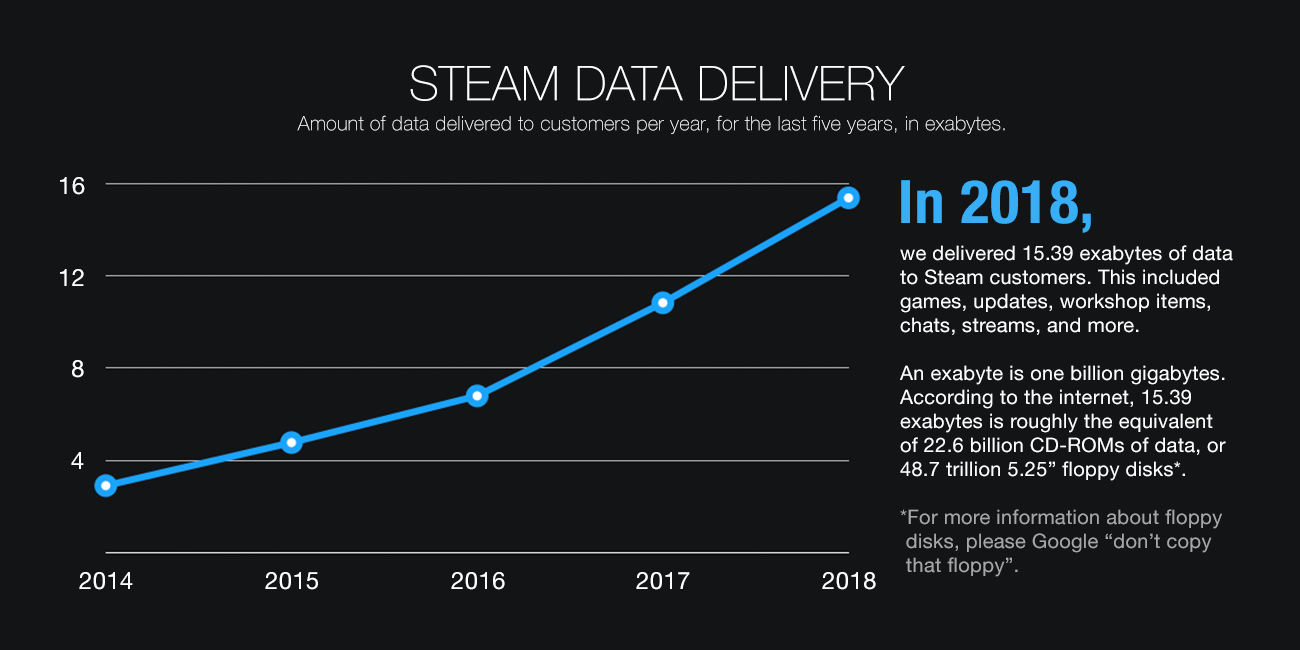Steam delivered 15 billion gigabytes of data in 2018
That's 15 exabytes of games and patches and trading cards over a network infrastructure Valve's been building since 2015.

You don't download Steam games over the internet. Not exactly. Over the past three years, Valve has been delivering its games and other data over a global private network it's been steadily building up, as it detailed in a 2018 year in review post today. "We partner with Internet backbone companies around the world to build this network, which connects directly with over 28,000 regional and local networks in 28 cities in 21 different countries," Valve writes. "This private network lets us deliver games and carry game, voice chat, and other data with high speeds and low latency to users in more than 229 countries."
What kind of speeds, exactly? Valve says its "edge network capacity" is now 12 Tbps (that's 12 million megabits per second). The "edge" here refers to the locations of servers users connect to. Cloudflare has a good breakdown: "An edge server often serves as the connection between separate networks. A primary purpose of a CDN edge server is to store content as close as possible to a requesting client machine, thereby reducing latency and improving page load times."
If you've ever marveled at how fast Steam's download servers are, there's at least part of the explanation. Valve says its network capacity is also growing 50 percent year over year.

That growth is likely necessary to keep up with the growing Steam userbase (and growing game download sizes). Steam's chart above shows that in 2014, it delivered less than four exabytes of game data, in total, to everyone who used Steam. That's still a lot: it's four billion gigabytes. But in 2018, Steam's total data delivery was 15.39 exabytes, quadruple where it was just a few years ago.
For a bit of fun perspective, Valve noted that it now delivers more game data in one year than there was internet traffic period when Steam launched: "The entire traffic of the Internet in 2003 (the year we launched Steam) is estimated at 9.3 exabytes."
A few more interesting facts and figures are in the details of Steam's server infrastructure. Some of Steam's major functionality is powered by a whole boatload of SSDs: "We deployed new SQL Servers, now with 2.7 petabytes of FAST solid state storage, to keep up with the 1.7 billion trading cards granted, the 488 million trades completed, the 245 million emoticons crafted, and the 218 million screenshots posted in the last year." We have to wonder what sort of SSDs Valve is using, because even using 16TB SAS models, that would still mean an array of 168 SSDs would be required.
Keep up to date with the most important stories and the best deals, as picked by the PC Gamer team.

Wes has been covering games and hardware for more than 10 years, first at tech sites like The Wirecutter and Tested before joining the PC Gamer team in 2014. Wes plays a little bit of everything, but he'll always jump at the chance to cover emulation and Japanese games.
When he's not obsessively optimizing and re-optimizing a tangle of conveyor belts in Satisfactory (it's really becoming a problem), he's probably playing a 20-year-old Final Fantasy or some opaque ASCII roguelike. With a focus on writing and editing features, he seeks out personal stories and in-depth histories from the corners of PC gaming and its niche communities. 50% pizza by volume (deep dish, to be specific).

